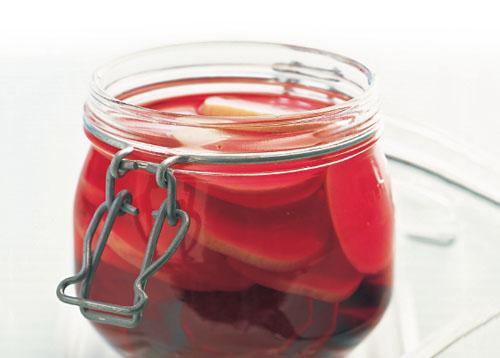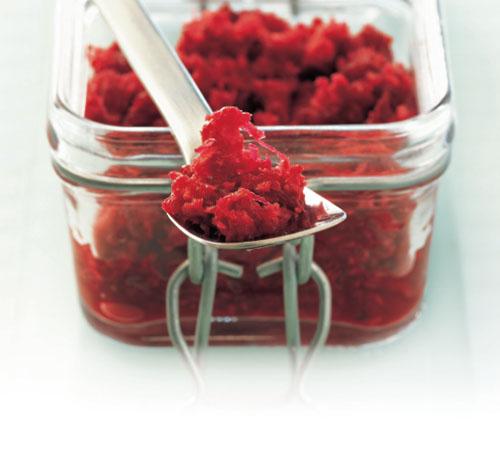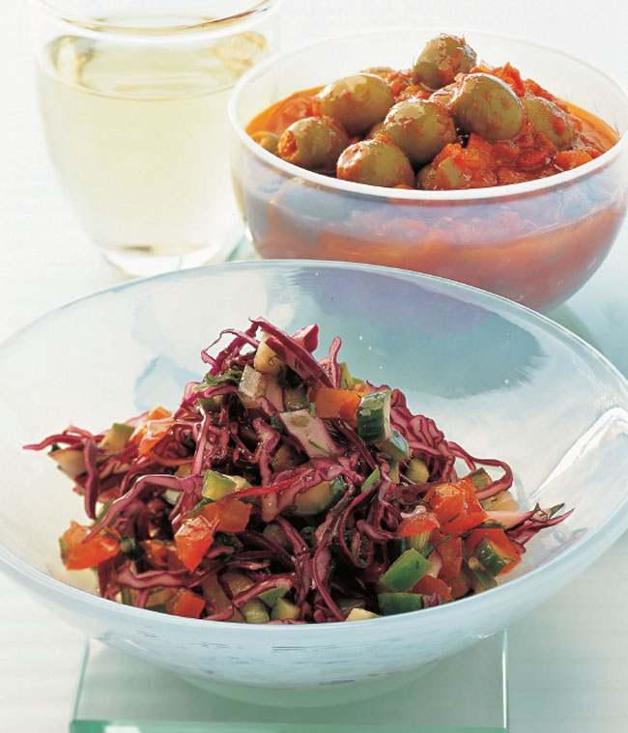Kosher and Traditional Jewish Cooking: Authentic Recipes From a Classic Culinary Heritage: 130 Delicious Dishes Shown in 220 Stunning Photographs (34 page)
Authors: Marlena Spieler
1
Wash the lemons well and cut each into six to eight wedges. Press a generous amount of salt into the cut surfaces, pushing it into every crevice.
2
Pack the salted lemon wedges into two 1.2 litre/2 pint sterilized jars. To each jar, add 30–45ml/2–3 tbsp salt and 90ml/6 tbsp lemon juice, then top up with boiling water, to cover the lemons. (If using larger jars, use more lemon juice and less boiling water.)
3
Cover the jars and leave to stand for 2–4 weeks before serving.
4
To serve, rinse the preserved lemons well to remove some of the salty flavour, then pull off the flesh and discard. Cut the lemon peel into strips or leave in chunks and use as desired.
COOK’S TIP
The salty, well-flavoured juice that is used to preserve the lemons can be added to salads or hot sauces, such as zchug, horef and harissa.
Nutritional information per jar: Energy 48kcal/198kJ; Protein 2.5g; Carbohydrate 8g, of which sugars 8g; Fat 0.8g, of which saturates 0.3g; Cholesterol 0mg; Calcium 213mg; Fibre 0g; Sodium 13mg.

The pickled turnips, deep rich red in their beetroot-spiked brine, not only look gorgeous in their jars but also make a delicious pickle to add to dishes like falafel or even as part of an assortment of appetizers before a main meal.
MAKES ABOUT 4 JARS
1kg/2
1
/
4
lb young turnips
3–4 raw beetroot (beets)
about 45ml/3 tbsp kosher salt or coarse sea salt
about 1.5 litres/2
1
/
2
pints/6
1
/
4
cups water
juice of 1 lemon
1
Wash the turnips and beetroot, but do not peel, then cut into slices 5mm/
1
/
4
in thick. Put the salt and water into a bowl, stir and leave until the salt has dissolved. Sprinkle the beetroot with lemon juice and place in the bases of four 1.2 litre/2 pint sterilized jars.
2
Top the beetroot with the turnips, packing them in very tightly. Carefully pour over the brine, making sure that the vegetables are completely covered. Seal the jars and leave them to stand in a cool, dry place for 7 days before serving.
Nutritional information per jar: Energy 85kcal/361kJ; Protein 3.5g; Carbohydrate 17.5g, of which sugars 16.5g; Fat 0.8g, of which saturates 0g; Cholesterol 0mg; Calcium 136mg; Fibre 7.4g; Sodium 4508mg.

This Ashkenazi horseradish and beetroot sauce is often eaten at Pesach, for which horseradish is one of the traditional bitter flavours. However, it is a delicious accompaniment to gefilte fish, fried fish patties or roasted meat at any time of the year.
SERVES 8
150g/5oz grated fresh horseradish
2 cooked beetroot (beets), grated
about 15ml/1 tbsp sugar
15–30ml/1–2 tbsp red wine vinegar
Salt
1
Put the horseradish and beetroot in a bowl and mix together, then season with sugar, vinegar and salt to taste.
2
Spoon the sauce into a sterilized jar, packing it down firmly, and seal. Store in the refrigerator, where it will keep for up to 2 weeks.
Nutritional information per portion: Energy 18kcal/74kJ; Protein 0.5g; Carbohydrate 4g, of which sugars 3.9g; Fat 0.1g, of which saturates 0g; Cholesterol 0mg; Calcium 14mg; Fibre 0.7g; Sodium 17mg.

and
tomato relish
This relish of green olives in a sauce of tomatoes and sweet peppers is wonderful served at a buffet with a selection of salads.
SERVES 10
45ml/3 tbsp extra virgin olive oil
1 green (bell) pepper, chopped or sliced
1 red (bell) pepper, chopped or sliced
1 onion, chopped
2–3 mild, large red and green chillies, thinly sliced
1–2 hot, small chillies, chopped or thinly sliced (optional)
5–7 garlic cloves, roughly chopped or thinly sliced
5–7 tomatoes, quartered or diced
5ml/1 tsp curry powder or hawaij
1.5ml/
1
/
4
tsp ground cumin
1.5ml/
1
/
4
tsp turmeric
large pinch of ground ginger
15ml/1 tbsp tomato purée (paste)
juice of
1
/
4
lemon, or to taste
200g/7oz/1
3
/
2
cups pitted or pimiento-stuffed green olives
1
Heat the oil in a pan and fry the peppers, onion and chillies for 5–10 minutes, or until softened.
2
Add the garlic and tomatoes and fry for 2–3 minutes, until the tomatoes have become the consistency of a sauce, then add the curry powder, the cumin, turmeric, ginger and tomato purée. Remove from the heat.
3
Stir in the lemon juice, then add the olives. Leave to cool, then chill, preferably overnight, before serving.
Nutritional information per portion: Energy 72kcal/299kJ; Protein 1g; Carbohydrate 4.3g, of which sugars 4g; Fat 5.8g, of which saturates 0.9g; Cholesterol 0mg; Calcium 20mg; Fibre 1.7g; Sodium 456mg.
This relish mixes the freshness and crunchiness of the salads enjoyed by Arabs with the chopped salads adored by Eastern Europeans.
SERVES 4
2–3 ripe tomatoes, finely chopped
1
/
2
cucumber, finely chopped
1
/
2
green (bell) pepper, finely chopped
1–2 garlic cloves, chopped
2 spring onions (scallions), sliced
30ml/2 tbsp finely chopped fresh mint, dill or coriander (cilantro) leaves
30ml/2 tbsp finely chopped fresh parsley
grated rind and juice of 1 lemon
1
/
8
red cabbage, chopped (optional)
salt
1
Put the tomatoes, cucumber, pepper, garlic, spring onions, herbs and lemon rind and juice together in a large serving bowl. Mix together well, then leave to chill until ready to serve.
2
If using red cabbage, add to the relish just before serving, as its colour will run and spoil the fresh and vibrant colours of all the other vegetables.
3
Add a little salt to taste and stir to mix until evenly combined. Serve immediately.
Nutritional information per portion: Energy 30kcal/126kJ; Protein 1.2g; Carbohydrate 5.6g, of which sugars 5.4g; Fat 0.5g, of which saturates 0.1g; Cholesterol 0mg; Calcium 14mg; Fibre 1.6g; Sodium 10mg.

Made of ground sesame seeds and flavoured with garlic and lemon juice, this makes a delicious dip, served with pitta bread, and can also be thinned with water and spooned over falafel.
SERVES 4–6
150g/5oz/
2
/
3
cup tahini
3 garlic cloves, finely chopped
juice of 1 lemon
1.5ml/
1
/
4
tsp ground cumin